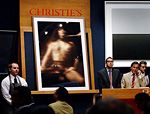Surge in antique buying
Surge of new private buyers in art and antiques market


The art and antiques market appears to be defying the recession, if buying trends at Maastricht and the weekend’s British Antique Dealers’ Association (BADA) fair in London are to be relied on. A downbeat exhibitor at BADA had opined ‘Maastricht’s different’, just before last week’s opening and, admittedly, the vast annual TEFAF fair at Maastricht is the pinnacle of the international art and antiques business. The British event is small and local by comparison, but both offer quality, and each has a loyal following, many of whom buy nowhere else. There were impatient crowds awaiting the opening in Chelsea just as there had been in the Dutch town two weeks earlier, and there was considerable buying from the moment the doors opened.
Again, as at Maastricht, buying spread across the board. If the market in ‘brown’ furniture really died a few years back, as was widely reported, it must now be rechristened Lazarus. As in other markets, quality sells. Wakelin & Lin-field reported a new Turkish buyer, admittedly for a French Empire item, and elsewhere, the best English and Irish pieces were stirring interest. Anthony Woodburn’s William and Mary timepiece by Daniel Quare, illustrated in last week’s COUNTRY LIFE (March 25), was among the earliest sales.
Certain areas are languishing because dealers have relied on long-established collectors, rather than encouraging new interest. According to an English-porcelain specialist, her clientele tends to be retired and dependent on pensions for investment income for activities such as collecting. This is not necessarily a good combination at present. On the other hand, it has been said that English watercolours have dropped entirely out of favour, but this was not the experience of John Spink, who not only sold a comparatively early J. M. W. Turner, but also took £30,000 for a Lake District view by the ‘other’ Turner, William of Oxford.
Maastricht was attended by representatives of museums from around the world even Havana and by all the top dealers, but much of the buying, as ever, was by private collectors. One of the most notable features of the BADA reports is the strength of new private buying. Stephen Jarrett of Witney Antiques, who had an excellent fair, said that a third of his sales, including furniture, clocks and textiles, were made to people who were new to him, and almost everything else mentioned here went to private buyers, many new to the exhibitor. As usual in recessions, there are plenty of opportunities for people who have cash to invest it very well and most enjoyably. At present, investing in art and antiques really is better than having money in the bank.
Sign up for the Country Life Newsletter
Exquisite houses, the beauty of Nature, and how to get the most from your life, straight to your inbox.
Country Life is unlike any other magazine: the only glossy weekly on the newsstand and the only magazine that has been guest-edited by HRH The King not once, but twice. It is a celebration of modern rural life and all its diverse joys and pleasures — that was first published in Queen Victoria's Diamond Jubilee year. Our eclectic mixture of witty and informative content — from the most up-to-date property news and commentary and a coveted glimpse inside some of the UK's best houses and gardens, to gardening, the arts and interior design, written by experts in their field — still cannot be found in print or online, anywhere else.
-
 A well-connected rural playground with 23 acres on the edge of the South Downs National Park
A well-connected rural playground with 23 acres on the edge of the South Downs National ParkOld House Farm is an impressive family home with a wealth of amenities that would inspire any rural passion.
By Arabella Youens Published
-
 The UK gets its first ‘European stork village’ — and it's in West Sussex
The UK gets its first ‘European stork village’ — and it's in West SussexAlthough the mortality rate among white storks can be up to 90%, the future looks rosy for breeding pairs in southern England.
By Rosie Paterson Published
